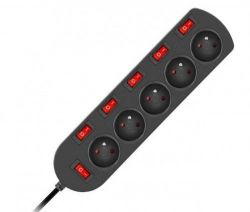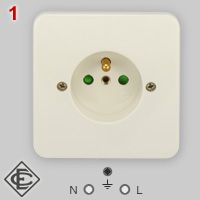

Czy wolisz polską wersję strony elektroda?
Nie, dziękuję Przekieruj mnie tamkkas12 wrote:This means that you will buy two cables with a plug, one with the brown wire on the right and the other on the left.
stomat wrote:And why do you ask?


pla20 wrote:There is an unwritten rule that in sockets the phase should be on the left and 0 on the right.
E8600 wrote:there are grounded sockets without a pin
BANANvanDYK wrote:
pla20 wrote:There is an unwritten rule that in sockets the phase should be on the left and 0 on the right.
The theory is wrong. The standards of all other countries that accept sockets as polarized refer to the phase contact on the RIGHT side.
But in Poland, sockets are considered unpolarized, which is why there are double sockets in which the polarity is reversed.
misiek1111 wrote:
misiek1111 wrote:Schuko, of course, is standard in De and A, not in Pl.
misiek1111 wrote:Schuko, of course, is standard in De and A
CYRUS2 wrote:What are these threats?
BANANvanDYK wrote:At a current of 12-14A, no fuse will trip.the protections inside the device will not be activated, but the protections in the electrical installation must be activated. As a result, for example, the tracks on the disc get burned
E8600 wrote:I share my colleague's opinion.I have one such cheap strip myself and I don't see much of a threat in it.
BANANvanDYK wrote:Meanwhile, in a neighboring country it is:
What should the manufacturer of the cable with plug do to ensure that the product meets ALL European standards?
pla20 wrote:There is an unwritten rule that in sockets the phase should be on the left and 0 on the right.
The theory is wrong. The standards of all other countries that accept sockets as polarized refer to the phase contact on the RIGHT side.
But in Poland, sockets are considered unpolarized, which is why there are double sockets in which the polarity is reversed.
CYRUS2 wrote:At a current of 12-14A, no fuse will trip.
Also the 10A fuse in the strip and the paths will burn.
William Bonawentura wrote:In the construction of the Polish People's Republic era, they were installed with the protective contact down
William Bonawentura wrote:For unknown reasons, some installers did not modify their assembly rules
BANANvanDYK wrote:Not so fast at all, since to this day there is a belief that it is only right to connect the phase on the left side of the socket.It's good that they withdrew from them quickly.
BANANvanDYK wrote:He informs his friend that PN-HD standards apply in Poland. Harmonized with the EU.And again, by some miracle, things must be different in Poland than in the rest of the world.
Mierzejewski46 wrote:Now you need to look for appropriate angle plugs with a connection cable on the same side as the socket for the PE pin. Unless you don't mind this kind of flair.Well, in my own kitchen I installed it in the style of the Polish People's Republic.
Mierzejewski46 wrote:But probably neither your wife nor you, nor the toaster, cares which side of the socket the phase is on?The art of compromise has been successful. My wife's happiness above all else.